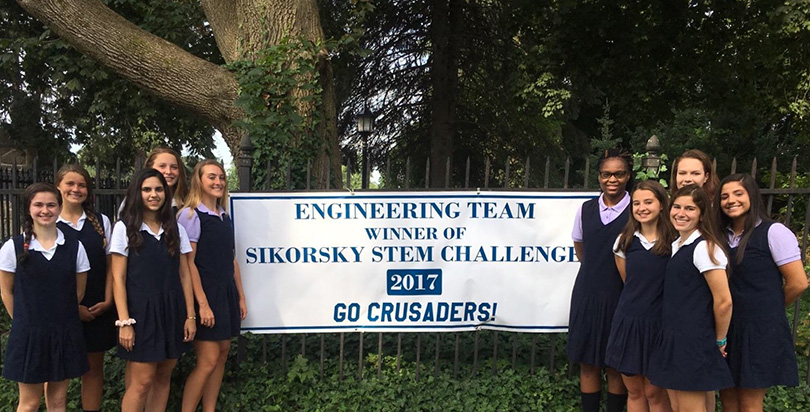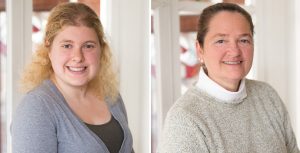When You Learn ‘Physics First’: How 2 STEM Teachers Led Their All-Girl Engineering Team From Worst to First in Aerospace Contest

It wasn’t the greatest feeling in the world.
Last fall, Theresa Napolitano and Danielle Kratter, teachers and engineering club mentors at the Lauralton Hall school in Milford, Connecticut, opened the results from an engineering competition and found that their students had come in last place. It was the first time the engineering team at the all-girls Catholic high school had participated in this invitation-only contest, run by the aircraft manufacturer Sikorsky.
The students were disappointed. After all, their team — the Wright Sisters — had worked hard to research and understand the challenge: design a fix for a broken aileron, a hinged flap on an airplane’s wings that helps it turn.
But it was a feeling the teachers and students knew how to work with.
This was just the first round — there were three more contests before the final challenge at year’s end. So they persisted in solving a problem none of them initially had understood. With each round, their standing rose against teams that had years of experience. And in May, the Wright Sisters won the top prize, going from worst to first in only seven months.
How did they do it? Napolitano and Kratter pointed to their school’s unique culture of enthusiasm and collaboration around STEM subjects, inspired by a physics-centered science curriculum and educators who encouraged experimentation.
“All of the girls in there had a foundation of physics and felt comfortable working with numbers and building and motion,” Napolitano said. “That concept helped them have confidence.”
Physics requires a different way of looking at the world, Napolitano and Kratter said, and that’s why Lauralton Hall decided that all students would learn physics during freshman year, before the traditional tracks of biology and chemistry. This practice is called Physics First, a movement practiced only in several thousand high schools but which has earned the support of educators and physicists. The idea is that physics not only complements the algebra that many ninth-graders are learning but also helps them better understand atoms, molecular biology, and the periodic table.

The science teachers at Lauralton Hall say their students fall in love with physics, and they encourage them to observe and discuss the things they see — even commenting from the backseat of their parents’ car that there actually had been enough time for dad to stop rather than speed through a yellow light.
Instead of dissecting frogs, the Lauralton Hall ninth-graders dissect toys to understand how energy works among the springs and coils. Around the holidays, students analyze the coefficient of friction between the sleigh and the roof in the song Grandma Got Run Over by a Reindeer. On what Napolitano calls junkyard day, she’ll instruct her students to open drawers filled with scraps and build something, without instruction.
“That’s the whole point of being creative: What they think will work sometimes doesn’t,” Napolitano said. She asks her students, “What was wrong with it that didn’t work, and what would you change?”
The teachers applied a similar approach to their engineering team. Napolitano and Kratter never led the meetings, but they would watch the girls solve problems and point them to resources or ask them guiding questions. “As educators, we were learning alongside them,” Kratter said. “This was something completely new for us.” Knowing that their teachers didn’t have the answers turned out to be a good thing for the girls, Kratter said, because it prompted student agency over their project.
The team met for several hours each week to work on their design challenge and would practice their presentations at home for the day when they would have to deliver their proposal before a panel including Sikorsky engineers. Helping them was a mentor assigned to them by the Sikorsky team, who also happened to be a Lauralton Hall graduate.
One of the team’s greatest strengths was the ability to collaborate, Napolitano and Kratter said. The girls listened, rather than talk over their peers’ ideas, and shared enthusiasm for one another’s strengths, such as a sophomore’s drawing skills that they used for sketching design ideas.
The students presented their final design solution to Sikorsky in the spring, undergoing a grilling from the judges that tested how well they grasped the design and engineering process, as well as their confidence in their solution. And in May, the Wright Sisters got some very different news from that of the fall. They had won the entire challenge. As with their experiments in physics class, persistence had paid off.
“Physics is a way of thinking and looking at the world,” Napolitano said. “What’s the impact on anything you do — in science, political science, English — anything you do, you need to understand that impact you put out there.”
Get stories like these delivered straight to your inbox. Sign up for The 74 Newsletter

;)
